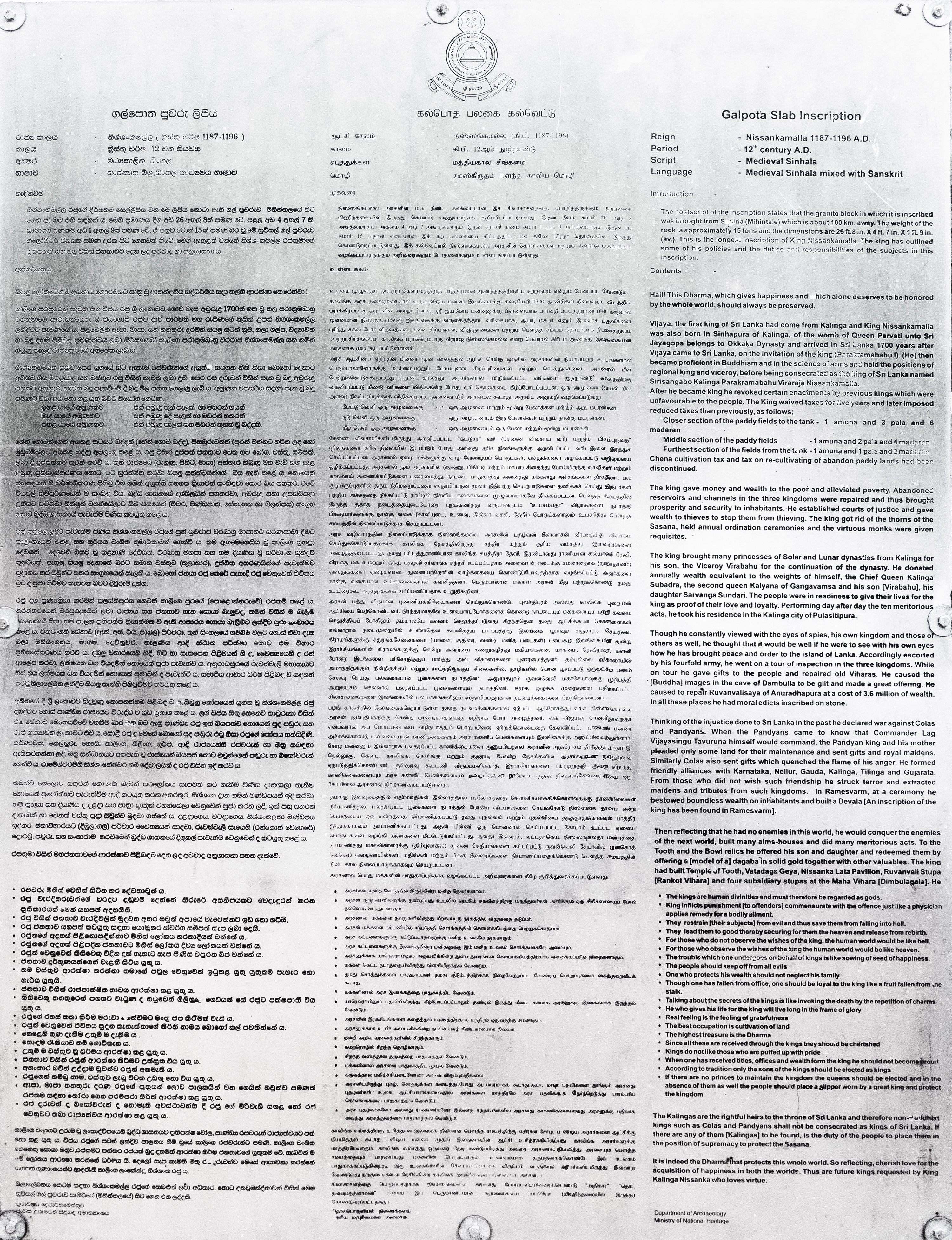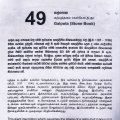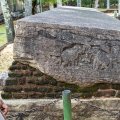Polonnaruwa (ancient city): photo 48
Photo 48 of 64 in Gallery: Polonnaruwa (ancient city)

Image title: Galpota Slab Inscription
Description of the photo
Galpota (Gal-pota) Slab Inscription—
Reign — Nissankamalla 1187-1196 A.D.
Period — 12th century A.D.
Script — Medieval Sinhala
Language — Medieval Sinhala mixed with Sanskrit
Introduction—
The postscript of the inscription states that the granite block in which it is inscribed was brought from Siria (Mihintale) which is about 100 km. away. The weight of the rock is approximately 15 tons and the dimensions are 26ft. 3in. X 4ft. 7in. X 1ft. 9in. (av.). This is the longest inscription of King Nissanka-Malla. The king has outlined some of his policies and the duties and responsibilities of the subjects in this inscription.
Contents—
Hail! This Dharma, which gives happiness and hich alone deserves to be honored by the whole world, should always be preserved.
Vijaya, the first king of Sri Lanka had come from Kalinga and King Nissankamalla was also born in Sinhapura of Kalinga, of the womb of Queen Parvati unto Sri Jayagopa belongs to Okkaka Dynasty and arrived in Sri Lanka 1700 years after Vijaya came to Sri Lanka, on the invitation of the king (Parakramabahu I). (He) then became proficient in Buddhism and in the science of arms and held the positions of regional king and viceroy, before being consecrated as the king of Sri Lanka named Sirisangabo Kalinga Parakramabahu Viraraja Nissanka-malla.
After he became king he revoked certain enactments by previous kings which were unfavourable to the people. The King waived taxes for five years and later imposed reduced taxes than previously, as follows;
Closer section of the paddy fields to the tank - 1 amuna and 3 pala and 6 madaran
Middle section of the paddy fields -1 amuna and 2 pala and 4 madaran
Furthest section of the fields from the took - 1 amuna and 1 pala and 3 madaran
Chena cultivation tax and tax on re-cultivating of abandon paddy lands had been discontinued.
The king gave money and wealth to the poor and alleviated poverty. Abandoned reservoirs and channels in the three kingdoms were repaired and thus brought prosperity and security to inhabitants. He established courts of justice and gave wealth to thieves to stop them from thieving. The king got rid of the thorns of the Sasana, held annual ordination ceremonies and the virtuous monks were given requisites.
The king brought many princesses of Solar and Lunar dynasties from Kalinga for his son, the Viceroy Virabahu for the continuation of the dynasty. He donated annually wealth equivalent to the weights of himself, the Chief Queen Kalinga Subadra, the second queen Kalyana of Gangavamsa and his son [Virabahu], his daughter Sarvanga Sundari. The people were in readiness to give their lives for the king as proof of their love and loyalty. Performing day after day the ten meritorious acts, he took his residence in the Kalinga city of Pulasitipura.
Though he constantly viewed with the eyes of spies, his own kingdom and those of others as well, he thought that it would be well if he were to see with his own eyes how he has brought peace and order to the island of Lanka. Accordingly escorted by his fourfold army, he went on a tour of inspection in the three kingdoms. While on tour he gave gifts to the people and repaired old Viharas. He caused the [Buddha] images in the cave of Dambulla to be gilt and made a great offering. He caused to repair Ruvanvalisaya of Anuradhapura at a cost of 3.6 million of wealth. In all these places he had moral edicts inscribed on stone.
Thinking of the injustice done to Sri Lanka in the past he declared war against Colas and Pandyans. When the Pandyans came to know that Commander Lag Vijayasingu Tavuruna himself would command, the Pandyan king and his mother pleaded only some land for their maintenance and sent gifts and royal maidens. Similarly Colas also sent gifts which quenched the flame of his anger. He formed friendly alliances with Karnataka, Nellur, Gauda, Kalinga, Tilinga and Gujarata. From those who did not wish such friendship he struck terror and extracted maidens and tributes from such kingdoms. In Ramesvarm, at a ceremony he bestowed boundless wealth on inhabitants and built a Devala [An inscription of the king has been found in Ramesvarm].
Then reflecting that he had no enemies in this world, he would conquer the enemies of the next world, built many alms-houses and did many meritorious acts. To the Tooth and the Bowl relics he offered his son and daughter and redeemed them by offering a [model of a] dagaba in solid gold together with other valuables. The king had built Temple of Tooth, Vatadaga Geya, Nissanka Lata Pavilion, Ruvanvali Stupa [Rankot Vihara] and four subsidiary stupas at the Maha Vihara [Dimbulagala]. He [???]
* The kings are human divinities and must therefore be regarded as gods.
* King inflicts punishment [to offenders] commensurate with the offence just like a physician applies remedy for a bodily ailment.
* They restrain [their subjects] from evil and thus save them from falling into hell.
* They lead them to good thereby securing for them the heaven and release from rebirth.
* For those who do not observe the wishes of the king, the human world would be like hell.
* For those who observe the wishes of the king the human world would be like heaven.
* The trouble which one undergoes on behalf of kings is like sowing of seed of happiness.
* The people should keep off from all evils
* One who protects his wealth should not neglect his family
* Though one has fallen from office, one should be loyal to the king like a fruit fallen from the stalk.
* Talking about the secrets of the kings is like invoking the death by the repetition of charms
* He who gives his life for the king will live long in the frame of glory
* Real feeling is the feeling of gratefulness
* The best occupation is cultivation of land
* The highest treasure is the Dharma
* Since all these are received through the kings they should be cherished
* Kings do not like those who are puffed up with pride
* When one has received titles, offices and wealth form the king he should not become proud
* According to tradition only the sons of the kings should be elected as kings
* If there are no princes to maintain the kingdom the queens should be elected and in the absence of them as well the people should place a slipper worn by a great king and protect the kingdom
The Kalingas are the rightful heirs to the throne of Sri Lanka and therefore non-Buddhist kings such as Colas and Pandyans shall not be consecrated as kings of Sri Lanka. If there are any of them [Kalingas] to be found, is the duty of the people to place them in the position of supremacy to protect the Sasana.
It is indeed the Dharma that protects this whole world. So reflecting, cherish love for the acquisition of happiness in both the worlds. Thus are future kings requested by King Kalinga Nissanka who loves virtue.
Gallery information:
These photographs were taken at the Polonnaruwa archaeological site which preserve some of the monuments and religious structures of the ancient kingdom of Polonnaruwa (also Pulathisipura or Vijayarajapura) of Sri Lanka dating to the 10th century CE. Some of the important kings who reigned in this kingdom are King Vijayabahu I and his grandson, king Prakramabahu the Great. The city and it's architecture were influenced by various religious such as Hinduism in its early history, Shaivism and later Buddhism.
Photo details:
Date: 2023-08-31
Camera: SONY ILCE-6400
Exposure: 1/160
Aperture: f/4
ISO: 1600
Focal length: 18mm
High resolution:
Download file
Size: 6.66 MB
Resolution: 3000 x 3906
© Photograph by Gabe Hiemstra.
License: CC BY-NC-ND 4.0

